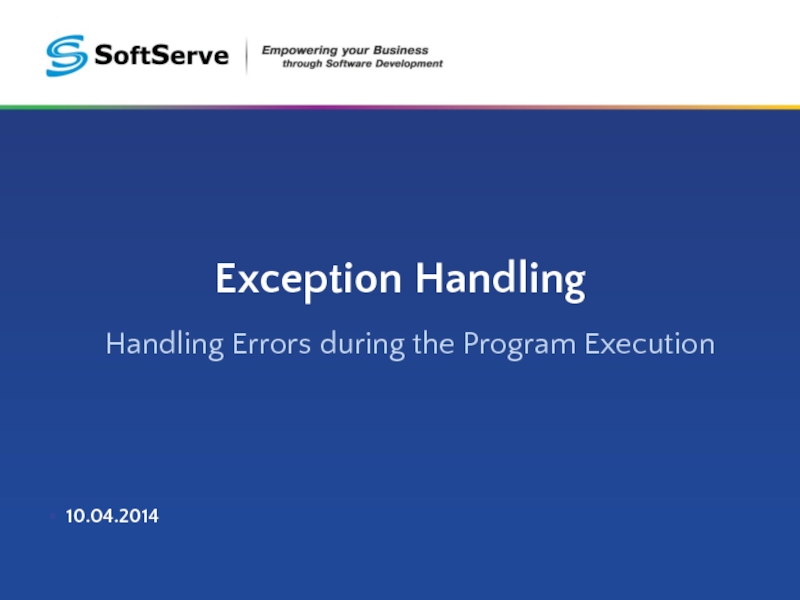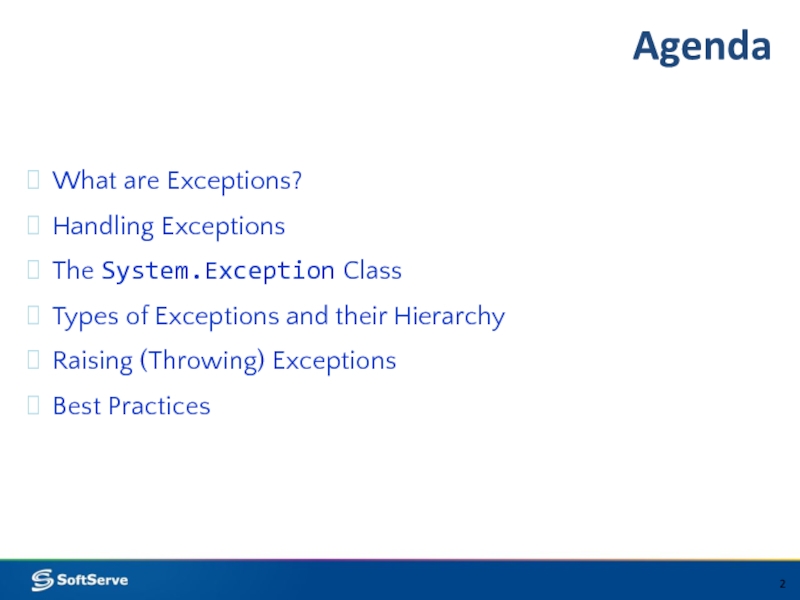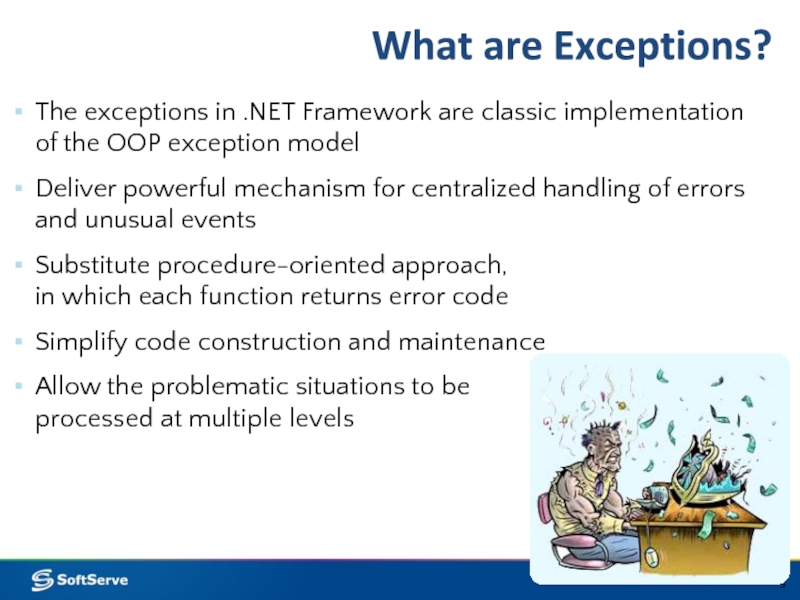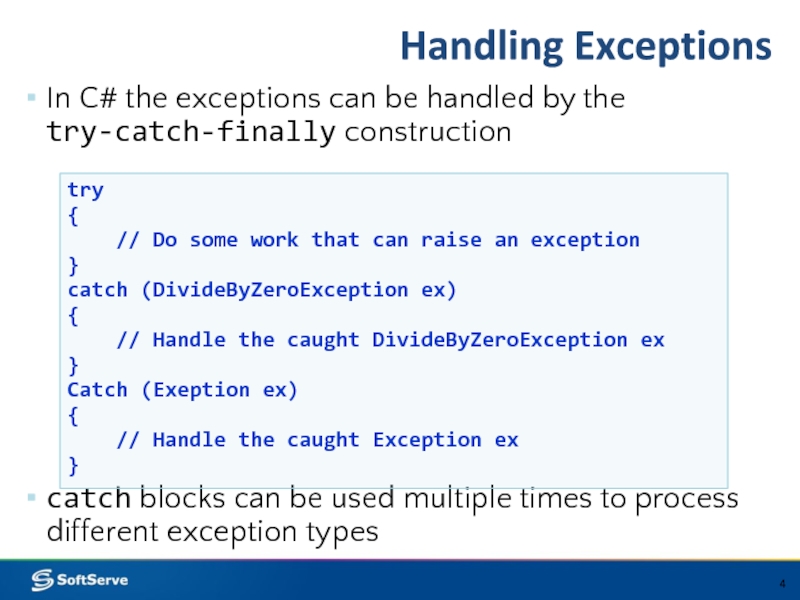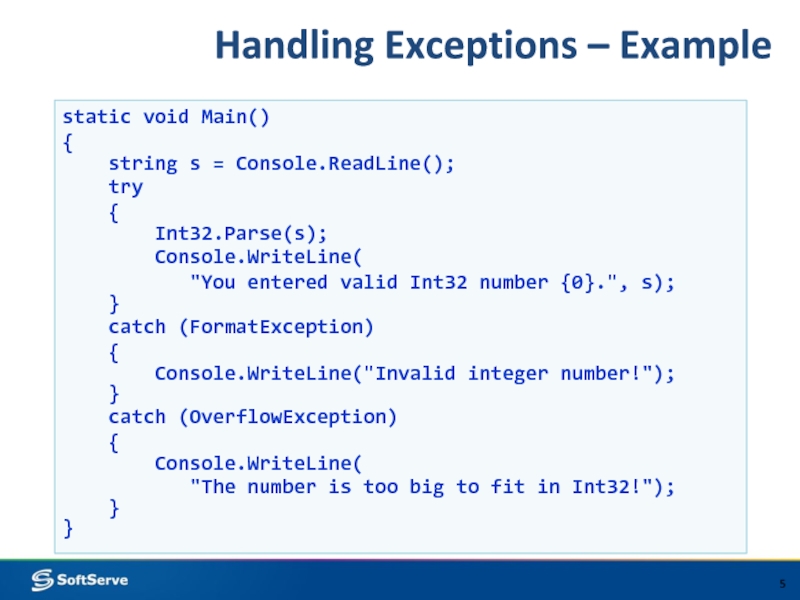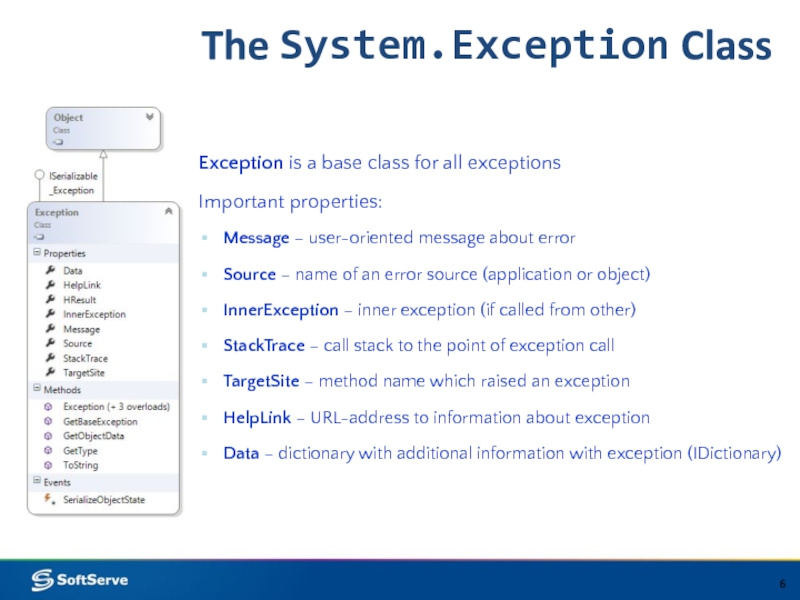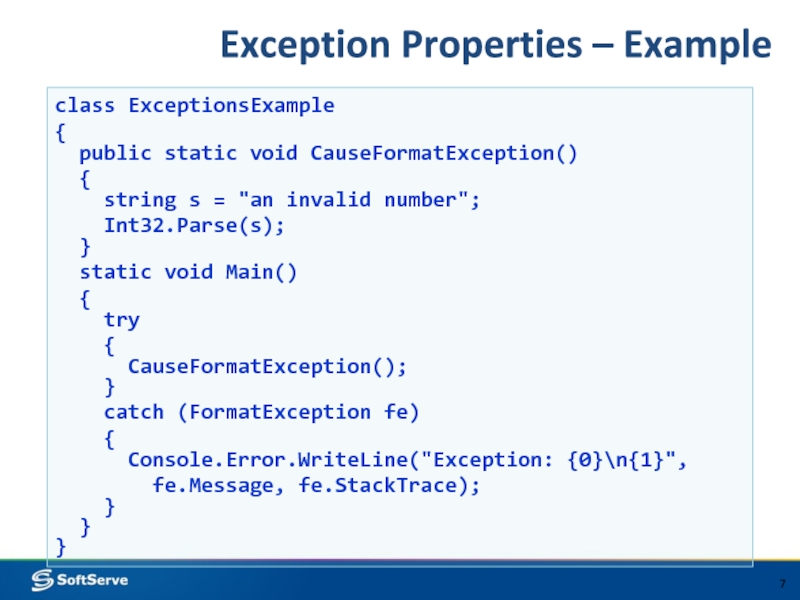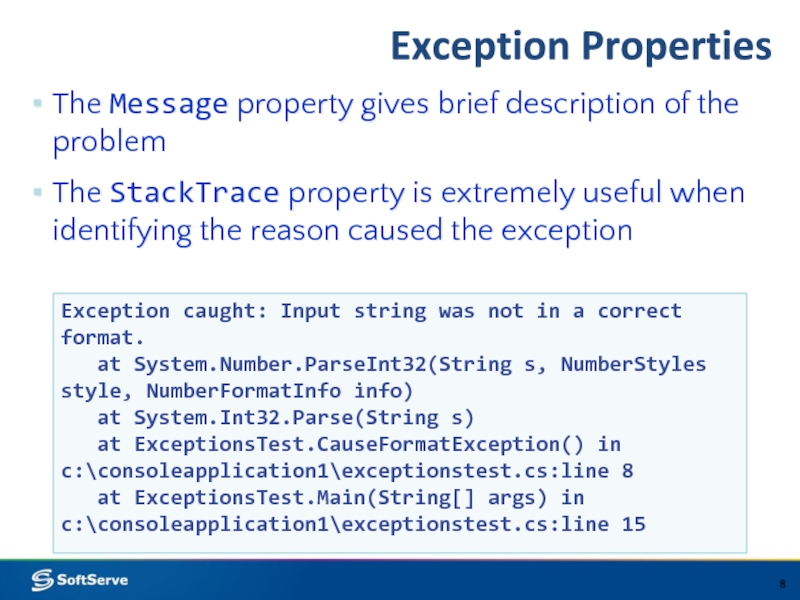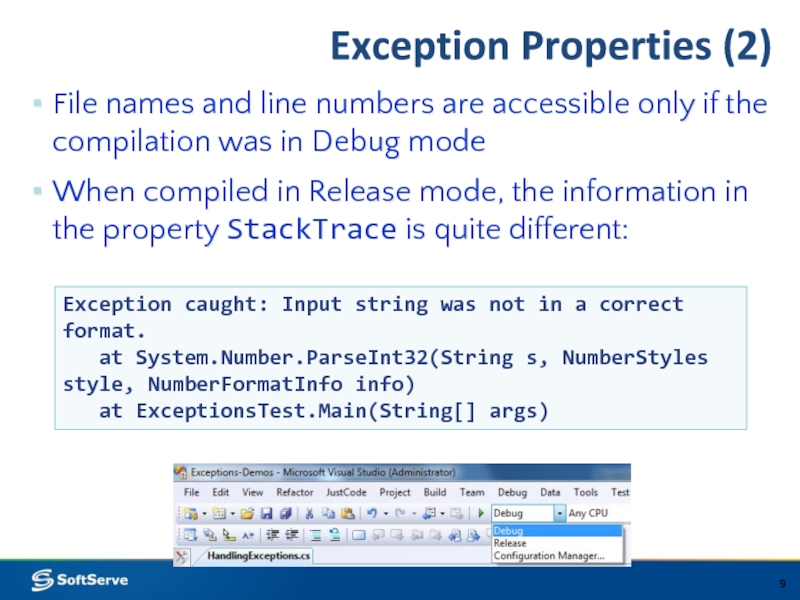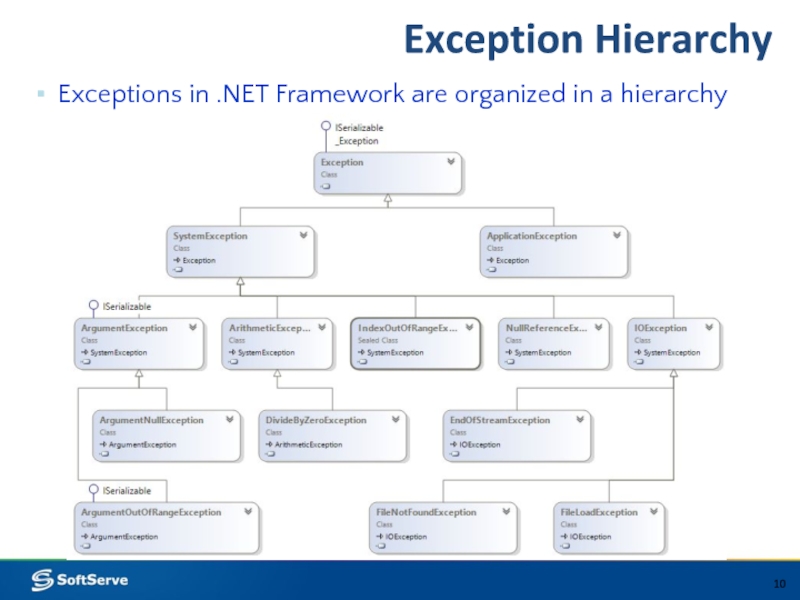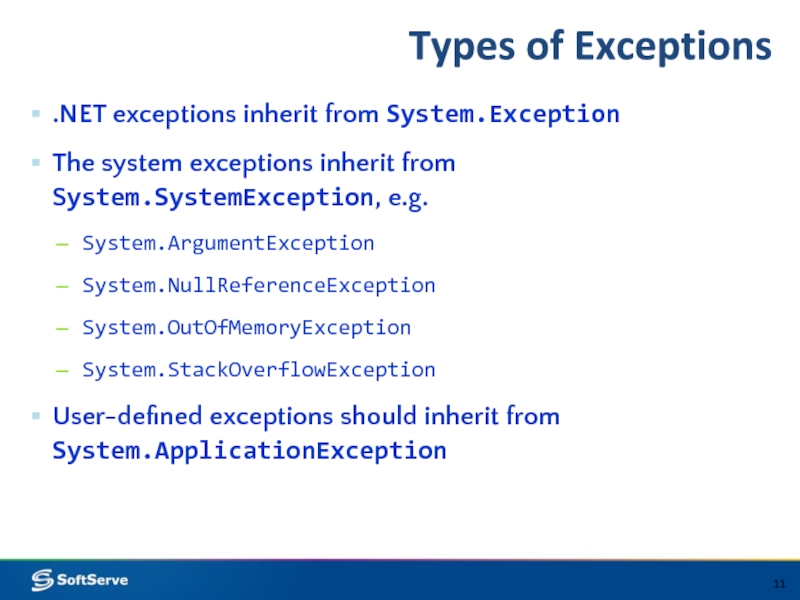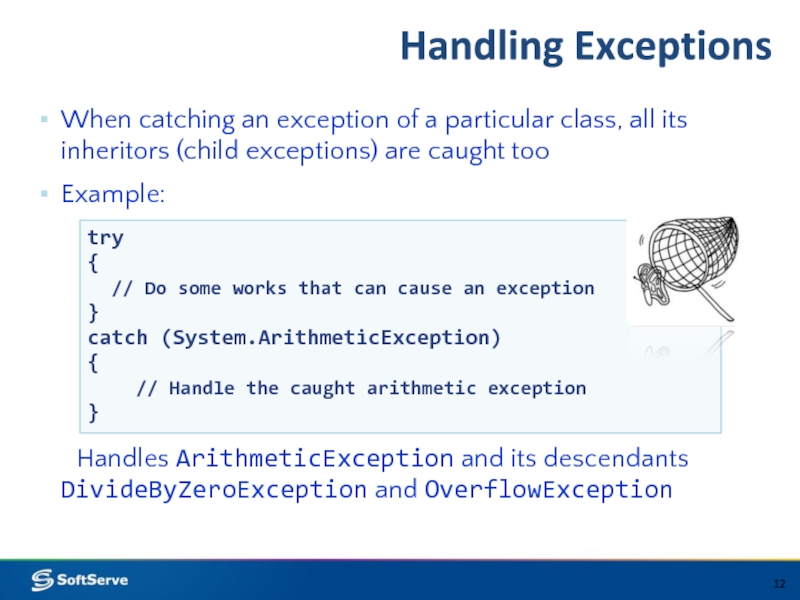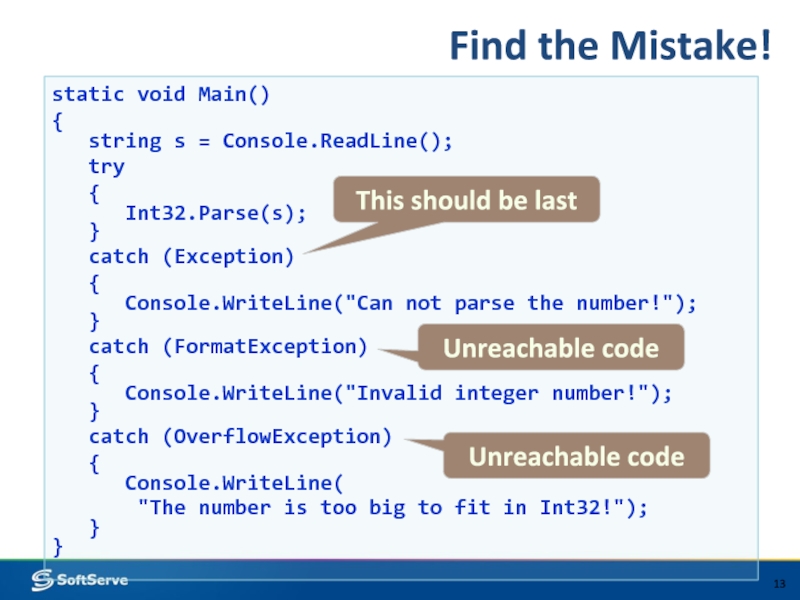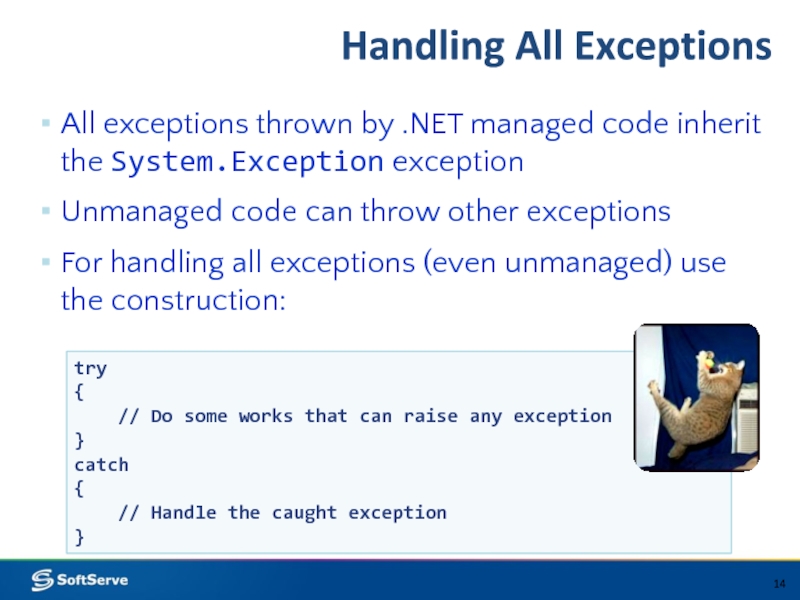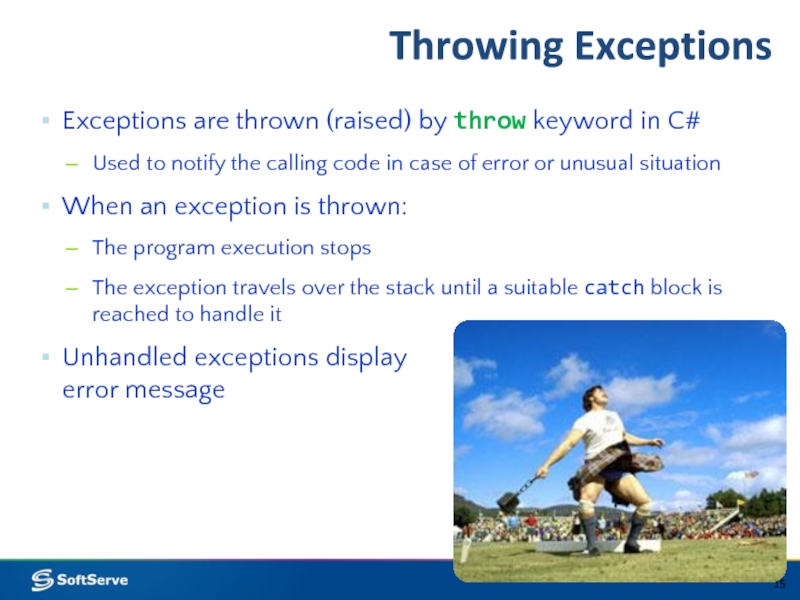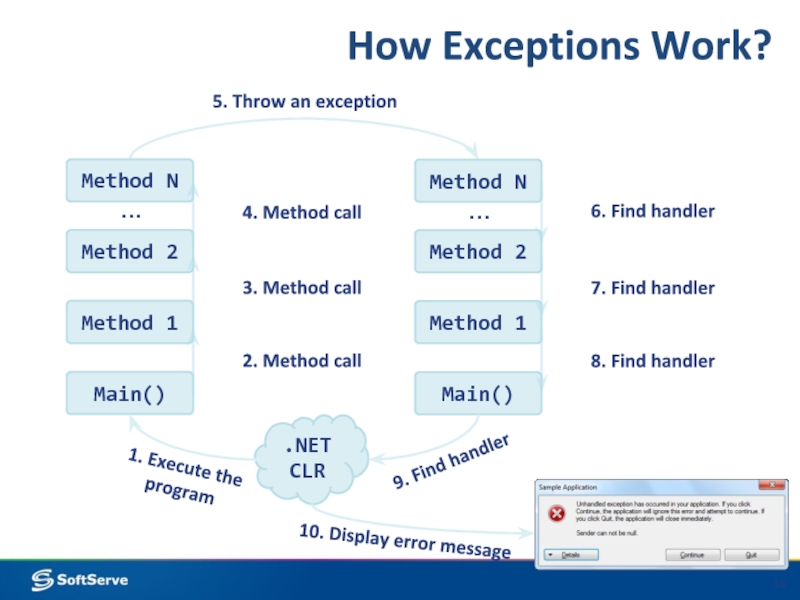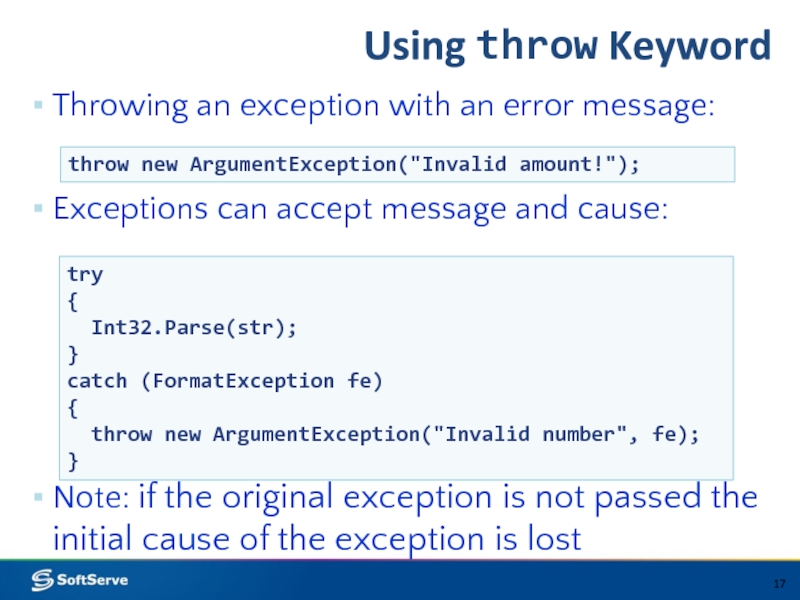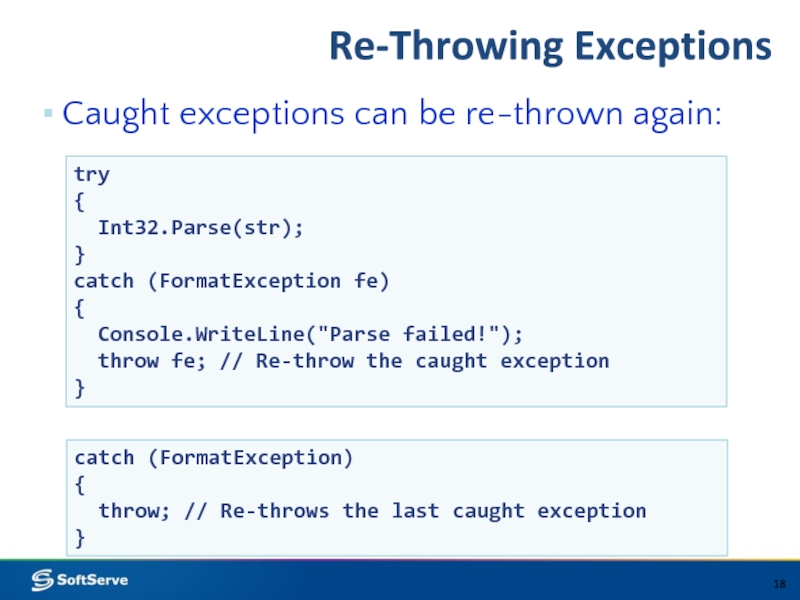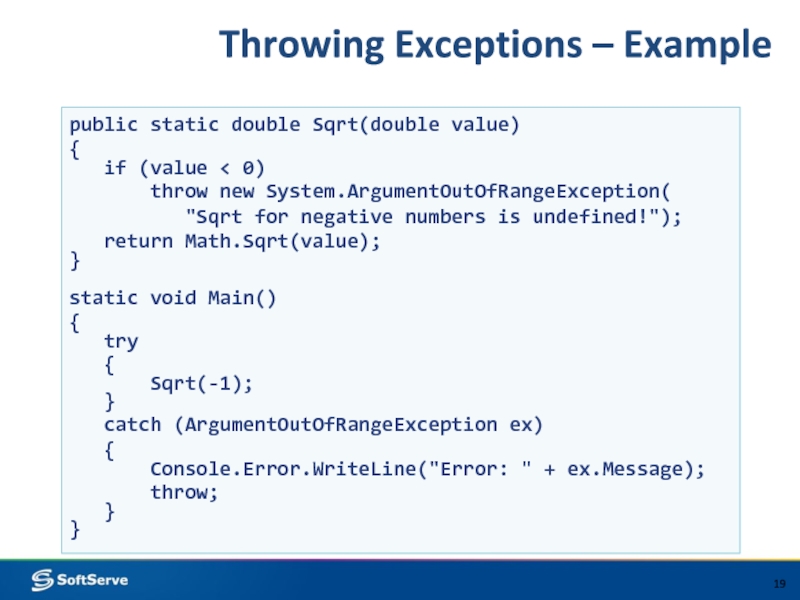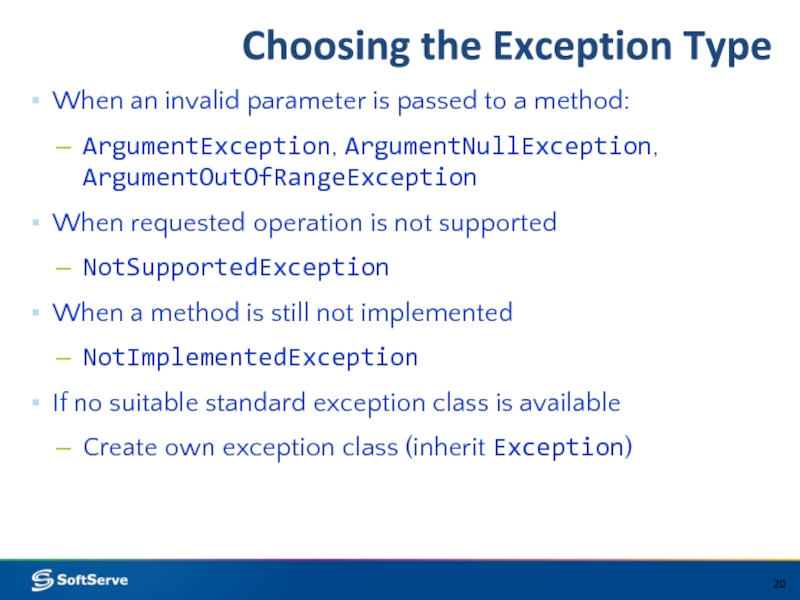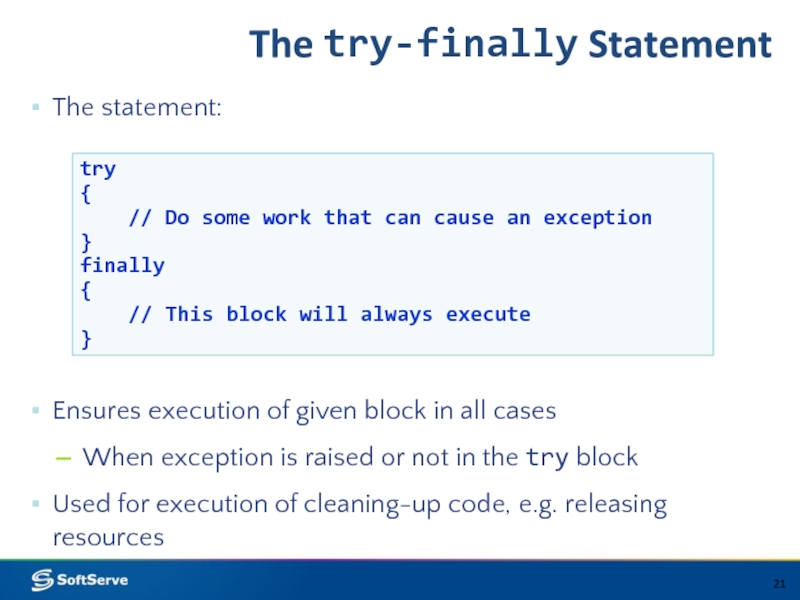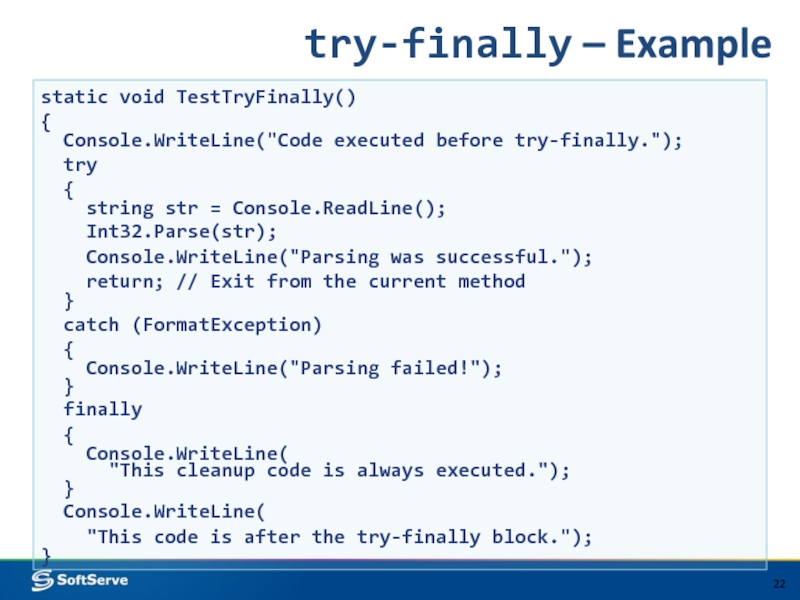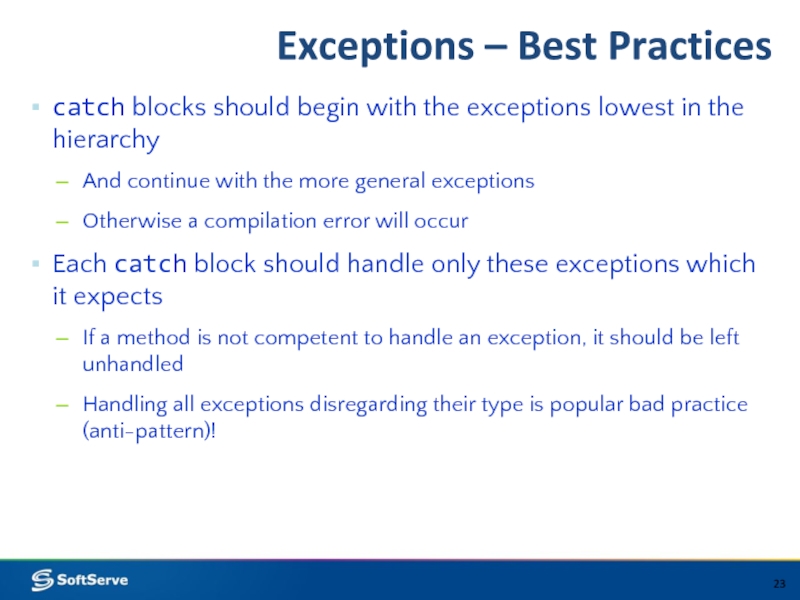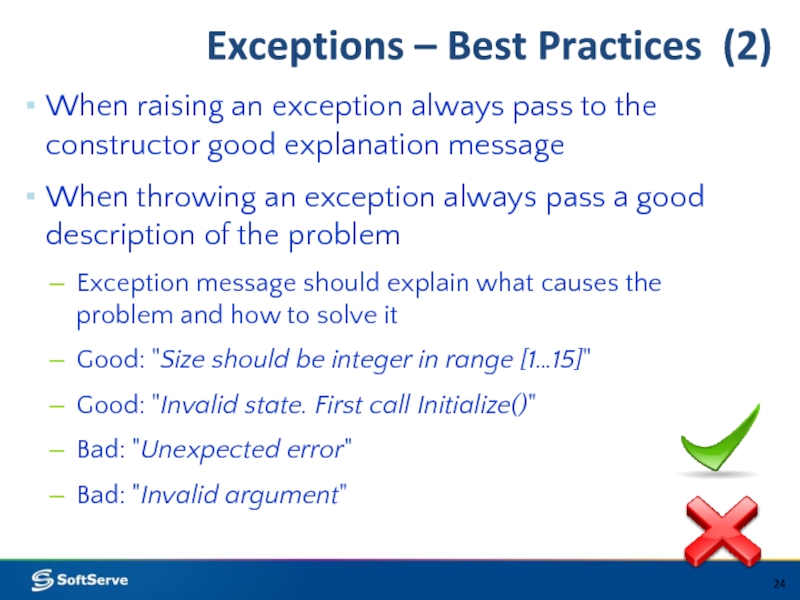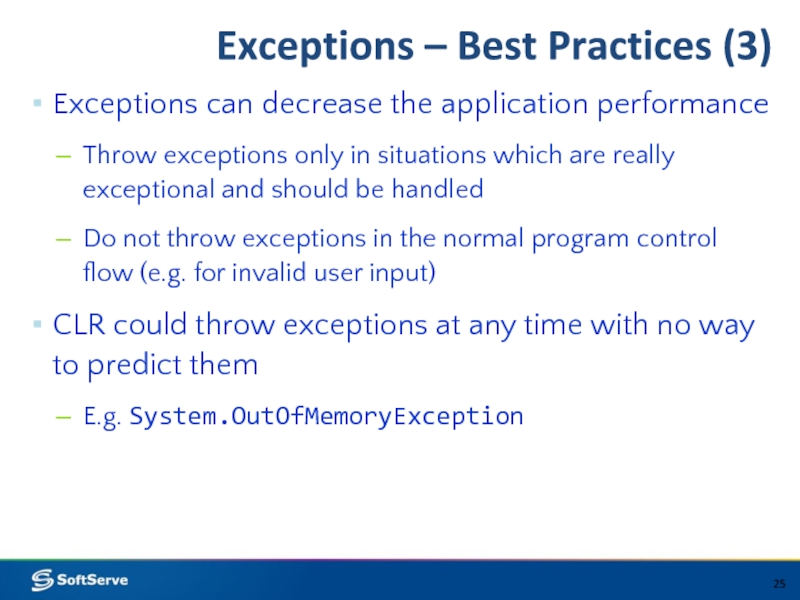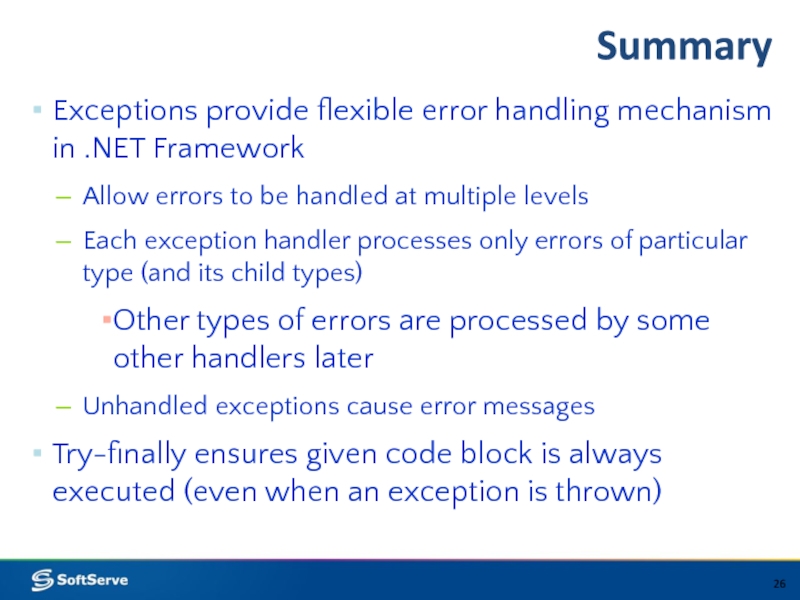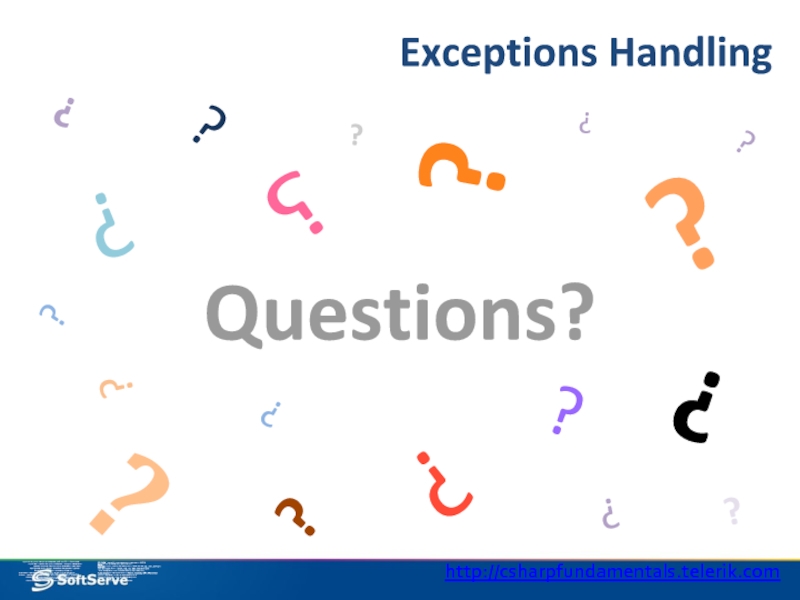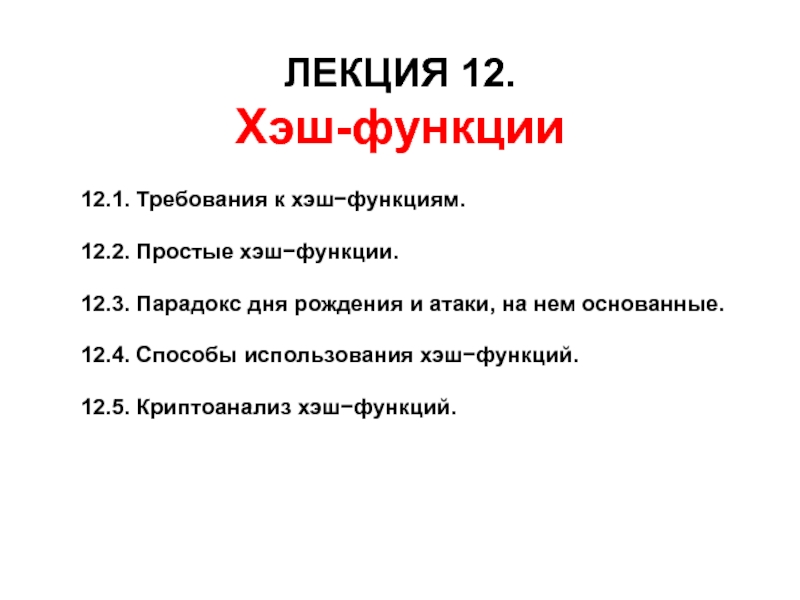- Главная
- Разное
- Дизайн
- Бизнес и предпринимательство
- Аналитика
- Образование
- Развлечения
- Красота и здоровье
- Финансы
- Государство
- Путешествия
- Спорт
- Недвижимость
- Армия
- Графика
- Культурология
- Еда и кулинария
- Лингвистика
- Английский язык
- Астрономия
- Алгебра
- Биология
- География
- Детские презентации
- Информатика
- История
- Литература
- Маркетинг
- Математика
- Медицина
- Менеджмент
- Музыка
- МХК
- Немецкий язык
- ОБЖ
- Обществознание
- Окружающий мир
- Педагогика
- Русский язык
- Технология
- Физика
- Философия
- Химия
- Шаблоны, картинки для презентаций
- Экология
- Экономика
- Юриспруденция
C# Exception handling. Handling Errors during the Program Execution презентация
Содержание
- 1. C# Exception handling. Handling Errors during the Program Execution
- 2. Agenda What are Exceptions? Handling Exceptions The
- 3. What are Exceptions? The exceptions in .NET
- 4. Handling Exceptions In C# the exceptions can
- 5. Handling Exceptions – Example static void Main()
- 6. The System.Exception Class Exception is a base
- 7. Exception Properties – Example class ExceptionsExample {
- 8. Exception Properties The Message property gives brief
- 9. Exception Properties (2) File names and line
- 10. Exception Hierarchy Exceptions in .NET Framework are organized in a hierarchy
- 11. Types of Exceptions .NET exceptions inherit from
- 12. Handling Exceptions When catching an exception of
- 13. Find the Mistake! static void Main() {
- 14. Handling All Exceptions All exceptions thrown by
- 15. Throwing Exceptions Exceptions are thrown (raised) by
- 16. How Exceptions Work? Main() Method 1
- 17. Using throw Keyword Throwing an exception with
- 18. Re-Throwing Exceptions Caught exceptions can be re-thrown
- 19. Throwing Exceptions – Example public static double
- 20. Choosing the Exception Type When an invalid
- 21. The try-finally Statement The statement:
- 22. try-finally – Example static void TestTryFinally() {
- 23. Exceptions – Best Practices catch blocks
- 24. Exceptions – Best Practices (2) When raising
- 25. Exceptions – Best Practices (3) Exceptions can
- 26. Summary Exceptions provide flexible error handling mechanism
- 27. Exceptions Handling http://csharpfundamentals.telerik.com
Слайд 2Agenda
What are Exceptions?
Handling Exceptions
The System.Exception Class
Types of Exceptions and their Hierarchy
Raising
Best Practices
Слайд 3What are Exceptions?
The exceptions in .NET Framework are classic implementation of
Deliver powerful mechanism for centralized handling of errors and unusual events
Substitute procedure-oriented approach, in which each function returns error code
Simplify code construction and maintenance
Allow the problematic situations to be processed at multiple levels
Слайд 4Handling Exceptions
In C# the exceptions can be handled by the try-catch-finally
catch blocks can be used multiple times to process different exception types
try
{
// Do some work that can raise an exception
}
catch (DivideByZeroException ex)
{
// Handle the caught DivideByZeroException ex
}
Catch (Exeption ex)
{
// Handle the caught Exception ex
}
Слайд 5Handling Exceptions – Example
static void Main()
{
string s = Console.ReadLine();
{
Int32.Parse(s);
Console.WriteLine(
"You entered valid Int32 number {0}.", s);
}
catch (FormatException)
{
Console.WriteLine("Invalid integer number!");
}
catch (OverflowException)
{
Console.WriteLine(
"The number is too big to fit in Int32!");
}
}
Слайд 6The System.Exception Class
Exception is a base class for all exceptions
Important properties:
Message
Source – name of an error source (application or object)
InnerException – inner exception (if called from other)
StackTrace – call stack to the point of exception call
TargetSite – method name which raised an exception
HelpLink – URL-address to information about exception
Data – dictionary with additional information with exception (IDictionary)
Слайд 7Exception Properties – Example
class ExceptionsExample
{
public static void CauseFormatException()
{
Int32.Parse(s);
}
static void Main()
{
try
{
CauseFormatException();
}
catch (FormatException fe)
{
Console.Error.WriteLine("Exception: {0}\n{1}",
fe.Message, fe.StackTrace);
}
}
}
Слайд 8Exception Properties
The Message property gives brief description of the problem
The StackTrace
Exception caught: Input string was not in a correct format.
at System.Number.ParseInt32(String s, NumberStyles style, NumberFormatInfo info)
at System.Int32.Parse(String s)
at ExceptionsTest.CauseFormatException() in c:\consoleapplication1\exceptionstest.cs:line 8
at ExceptionsTest.Main(String[] args) in c:\consoleapplication1\exceptionstest.cs:line 15
Слайд 9Exception Properties (2)
File names and line numbers are accessible only if
When compiled in Release mode, the information in the property StackTrace is quite different:
Exception caught: Input string was not in a correct format.
at System.Number.ParseInt32(String s, NumberStyles style, NumberFormatInfo info)
at ExceptionsTest.Main(String[] args)
Слайд 11Types of Exceptions
.NET exceptions inherit from System.Exception
The system exceptions inherit from
System.ArgumentException
System.NullReferenceException
System.OutOfMemoryException
System.StackOverflowException
User-defined exceptions should inherit from System.ApplicationException
Слайд 12Handling Exceptions
When catching an exception of a particular class, all its
Example:
Handles ArithmeticException and its descendants DivideByZeroException and OverflowException
try
{
// Do some works that can cause an exception
}
catch (System.ArithmeticException)
{
// Handle the caught arithmetic exception
}
Слайд 13Find the Mistake!
static void Main()
{
string s = Console.ReadLine();
{
Int32.Parse(s);
}
catch (Exception)
{
Console.WriteLine("Can not parse the number!");
}
catch (FormatException)
{
Console.WriteLine("Invalid integer number!");
}
catch (OverflowException)
{
Console.WriteLine(
"The number is too big to fit in Int32!");
}
}
This should be last
Unreachable code
Unreachable code
Слайд 14Handling All Exceptions
All exceptions thrown by .NET managed code inherit the
Unmanaged code can throw other exceptions
For handling all exceptions (even unmanaged) use the construction:
try
{
// Do some works that can raise any exception
}
catch
{
// Handle the caught exception
}
Слайд 15Throwing Exceptions
Exceptions are thrown (raised) by throw keyword in C#
Used to
When an exception is thrown:
The program execution stops
The exception travels over the stack until a suitable catch block is reached to handle it
Unhandled exceptions display error message
Слайд 16How Exceptions Work?
Main()
Method 1
Method 2
Method N
2. Method call
3. Method call
4. Method
…
Main()
Method 1
Method 2
Method N
8. Find handler
7. Find handler
6. Find handler
…
5. Throw an exception
.NET CLR
1. Execute the
program
9. Find handler
10. Display error message
Слайд 17Using throw Keyword
Throwing an exception with an error message:
Exceptions can accept
Note: if the original exception is not passed the initial cause of the exception is lost
throw new ArgumentException("Invalid amount!");
try
{
Int32.Parse(str);
}
catch (FormatException fe)
{
throw new ArgumentException("Invalid number", fe);
}
Слайд 18Re-Throwing Exceptions
Caught exceptions can be re-thrown again:
try
{
Int32.Parse(str);
}
catch (FormatException fe)
{
Console.WriteLine("Parse
throw fe; // Re-throw the caught exception
}
catch (FormatException)
{
throw; // Re-throws the last caught exception
}
Слайд 19Throwing Exceptions – Example
public static double Sqrt(double value)
{
if (value
throw new System.ArgumentOutOfRangeException(
"Sqrt for negative numbers is undefined!");
return Math.Sqrt(value);
}
static void Main()
{
try
{
Sqrt(-1);
}
catch (ArgumentOutOfRangeException ex)
{
Console.Error.WriteLine("Error: " + ex.Message);
throw;
}
}
Слайд 20Choosing the Exception Type
When an invalid parameter is passed to a
ArgumentException, ArgumentNullException, ArgumentOutOfRangeException
When requested operation is not supported
NotSupportedException
When a method is still not implemented
NotImplementedException
If no suitable standard exception class is available
Create own exception class (inherit Exception)
Слайд 21The try-finally Statement
The statement:
Ensures execution of given block in all cases
When
Used for execution of cleaning-up code, e.g. releasing resources
try
{
// Do some work that can cause an exception
}
finally
{
// This block will always execute
}
Слайд 22try-finally – Example
static void TestTryFinally()
{
Console.WriteLine("Code executed before try-finally.");
try
{
Int32.Parse(str);
Console.WriteLine("Parsing was successful.");
return; // Exit from the current method
}
catch (FormatException)
{
Console.WriteLine("Parsing failed!");
}
finally
{
Console.WriteLine(
"This cleanup code is always executed.");
}
Console.WriteLine(
"This code is after the try-finally block.");
}
Слайд 23Exceptions – Best Practices
catch blocks should begin with the exceptions
And continue with the more general exceptions
Otherwise a compilation error will occur
Each catch block should handle only these exceptions which it expects
If a method is not competent to handle an exception, it should be left unhandled
Handling all exceptions disregarding their type is popular bad practice (anti-pattern)!
Слайд 24Exceptions – Best Practices (2)
When raising an exception always pass to
When throwing an exception always pass a good description of the problem
Exception message should explain what causes the problem and how to solve it
Good: "Size should be integer in range [1…15]"
Good: "Invalid state. First call Initialize()"
Bad: "Unexpected error"
Bad: "Invalid argument"
Слайд 25Exceptions – Best Practices (3)
Exceptions can decrease the application performance
Throw exceptions
Do not throw exceptions in the normal program control flow (e.g. for invalid user input)
CLR could throw exceptions at any time with no way to predict them
E.g. System.OutOfMemoryException
Слайд 26Summary
Exceptions provide flexible error handling mechanism in .NET Framework
Allow errors to
Each exception handler processes only errors of particular type (and its child types)
Other types of errors are processed by some other handlers later
Unhandled exceptions cause error messages
Try-finally ensures given code block is always executed (even when an exception is thrown)
